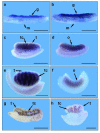The Ter mutation in the dead end gene causes germ cell loss and testicular germ cell tumours
- PMID: 15902260
- PMCID: PMC1421521
- DOI: 10.1038/nature03595
The Ter mutation in the dead end gene causes germ cell loss and testicular germ cell tumours
Abstract
In mice, the Ter mutation causes primordial germ cell (PGC) loss in all genetic backgrounds. Ter is also a potent modifier of spontaneous testicular germ cell tumour (TGCT) susceptibility in the 129 family of inbred strains, and markedly increases TGCT incidence in 129-Ter/Ter males. In 129-Ter/Ter mice, some of the remaining PGCs transform into undifferentiated pluripotent embryonal carcinoma cells, and after birth differentiate into various cells and tissues that compose TGCTs. Here, we report the positional cloning of Ter, revealing a point mutation that introduces a termination codon in the mouse orthologue (Dnd1) of the zebrafish dead end (dnd) gene. PGC deficiency is corrected both with bacterial artificial chromosomes that contain Dnd1 and with a Dnd1-encoding transgene. Dnd1 is expressed in fetal gonads during the critical period when TGCTs originate. DND1 has an RNA recognition motif and is most similar to the apobec complementation factor, a component of the cytidine to uridine RNA-editing complex. These results suggest that Ter may adversely affect essential aspects of RNA biology during PGC development. DND1 is the first protein known to have an RNA recognition motif directly implicated as a heritable cause of spontaneous tumorigenesis. TGCT development in the 129-Ter mouse strain models paediatric TGCT in humans. This work will have important implications for our understanding of the genetic control of TGCT pathogenesis and PGC biology.
Figures




References
-
- Sakurai T, Iguchi T, Moriwaki K, Noguchi M. The ter mutation first causes primordial germ cell deficiency in ter/ter mouse embryos at 8 days of gestation. Develop. Growth Differ. 1995;37:293–302. - PubMed
-
- Noguchi T, Noguchi M. A recessive mutation (ter) causing germ cell deficiency and a high incidence of congenital testicular teratomas in 129/Sv-ter mice. J. Natl. Cancer Inst. 1985;75:385–392. - PubMed
-
- Stevens LC. A new inbred subline of mice (129-terSv) with a high incidence of spontaneous congenital testicular teratomas. J. Natl. Cancer Inst. 1973;50:235–242. - PubMed
-
- Stevens LC, Mackensen JA. Genetic and environmental influences on teratocarcinogenesis in mice. J. Natl. Cancer Inst. 1961;27:443–453.
-
- Stevens LC. Origin of testicular teratomas from primordial germ cells in mice. J. Natl. Cancer Inst. 1967;38:549–552. - PubMed
Publication types
MeSH terms
Substances
Grants and funding
LinkOut - more resources
Full Text Sources
Other Literature Sources
Medical
Molecular Biology Databases

